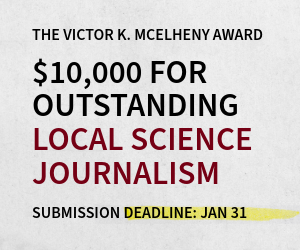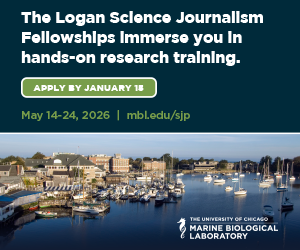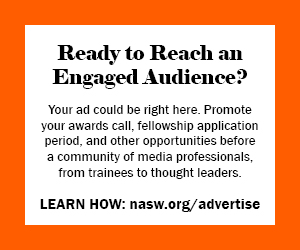A perfectly legal way for freelance writers to trim taxes is to employ their children. Their salaries stay in the family, but are shifted into their lower tax bracket. The jobs also put some “jingle in their jeans,” familiarize them with freelancing, and instill a bit of the old work ethic.
Science writing news
Paul Raeburn: Two years ago, I felt lucky to announce that I had been lured to the Sunshine State by Florida Atlantic University, which offered me a free hand to develop a new master’s program in science writing. Sadly, all has come tumbling down.
The Open Notebook has collected the thoughts of a half-dozen editors who took queries during the popular Pitch Slam at ScienceWriters2012. The six — Laura Helmuth, Amanda Moon, David Corcoran, Beth Quill, Susannah Locke, and Tasha Eichenseher — discuss what they look for (one word: "voice") and whether they prefer short or long queries: "Finally, remember that the best way to figure out what editors are looking for is to read the publication."
Spyfall: Finding a way to bring science to the David Petraeus-Paula Broadwell-Jill Kelley-John Allen-Frederick Humphries II-CIA-FBI-Pentagon-Gmail scandal. Lessons for digital privacy: There isn't any. If only Petraeus had known about oxytocin and the evolutionary trend toward monogamy. An oxytocin variant in C. elegans. A vegetative patient speaks, in a manner of speaking. The people speak too, and vote for legal marijuana. The result: more research and more work for science writers.
Joel Shurkin: Forty-three years ago this summer I covered one of the most important stories in human history: The first human landings on another world. Apollo 11. Neil Armstrong. The moon. It was a different journalism world then, and a different America. The media were concentrated, rich, powerful. America was self-assured, rich, daring. Children, you missed a wonderful time.
Last month in Raleigh, N.C., during the NASW business meeting, three dedicated volunteers were awarded the 2012 Diane McGurgan Service Award. Congratulations to Rick Bogren, Robert Irion, and Mari Jensen. Read on to learn more about their contributions and the award.
On July 11, 2012, an investigation I had worked on for approximately six months appeared simultaneously on TheAtlantic.com, Good Morning America, and ABC News’ World News Tonight. I am a freelancer. If you know anything about the freelance marketplace, you’ll spot at once that those two sentences don’t go together.
Hurricane Sandy and the science of weather. There's no way to know if human-caused global warming made Sandy worse--but humans are definitely responsible for the degree of devastation . Links to many Sandy photos. Sandy killed thousands of lab mice and rats but gave life to birders. Sandy, Presidential politics, and suddenly climate change is an election issue at last. The politics of health care and the Nate Silver backlash. Yes, it's yet more on Jonah Lehrer.
Reports are coming in quickly from the ScienceWriters2012 conference in Raleigh, N.C.. You can read the first reports on our conference reports page. They include "Do PIOs need science journalists any more?" and "Writing science ebooks in the real world." More reports will be posted in coming days, along with photos from conference events. Also, it's time to start thinking about ScienceWriters2013.
For seven exhilarating minutes this past August, the newsroom at the Jet Propulsion Laboratory crackled with the human electricity of telepresence. In those moments, hundreds of reporters, jammed elbow-to-elbow, were joined by a global audience drawn directly into the heartbeat of a breaking-news event.



